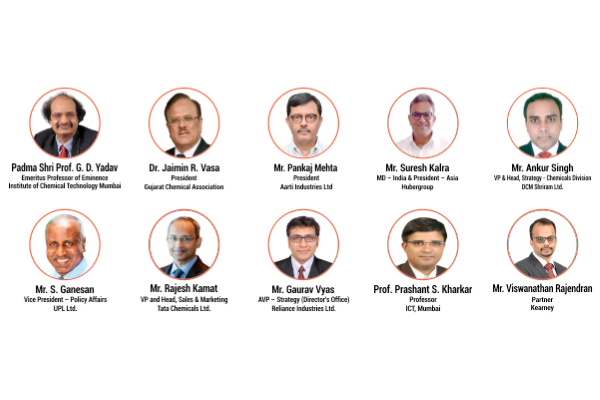Padma Shri Prof. G. D. Yadav, Emeritus Professor of Eminence, ICT, Mumbai; Dr. Jaimin R. Vasa, President, GCA; Pankaj Mehta, President, Aarti Industries; Suresh Kalra, MD – India & President Asia, hubergroup; Ankur Singh, Vice President & Head, Strategy – Chemicals Division, DCM Shriram; S. Ganesan, Vice President – Policy Affairs, UPL; Rajesh Kamat, Vice President and Head, Sales & Marketing, Tata Chemicals; Gaurav Vyas, AVP – Strategy (Director's Office), RIL; Prof. Prashant S. Kharkar, Professor, ICT, Mumbai; and Viswanathan Rajendran, Partner, Kearney are speakers

Indian Chemical News, the most credible digital media platform for the chemicals and allied sectors, is organising a panel discussion on “Achieving US $2 Trillion by 2047: Mission Im-Possible” during the 4th edition of the ‘NextGen Chemicals & Petrochemicals Summit 2024’ on July 11, 2024 at the Novotel Mumbai International Airport, Mumbai. The theme of this year’s Summit-cum-Conference is "Transforming India into a Global Manufacturing Hub.”
Please register for the Summit by clicking to the link: (https://www.indianchemicalnews.com/nextgen-chemical-and-petrochemical-summit-2024/register.php).
Speakers for Achieving US $2 Tn by 2040 Session during the 4th Edition of NextGen Chemicals & Petrochemicals Summit, organised by Indian Chemical News, India's No. 1 news portal on Chemical, Petrochemical and Energy, are: Padma Shri Prof. G. D. Yadav, Emeritus Professor of Eminence, ICT, Mumbai; Dr. Jaimin R. Vasa, President, Gujarat Chemical Association; Pankaj Mehta, President, Aarti Industries Ltd.; Suresh Kalra, MD – India & President Asia, hubergroup; Ankur Singh, Vice President & Head, Strategy – Chemicals Division, DCM Shriram Ltd.; S. Ganesan, Vice President – Policy Affairs, UPL Ltd.; Rajesh Kamat, Vice President and Head, Sales & Marketing, Tata Chemicals; Gaurav Vyas, AVP – Strategy (Director's Officece), Reliance Industries Ltd.; and Prof. Prashant S. Kharkar, Professor, ICT, Mumbai. The moderator of the session is Viswanathan Rajendran, Partner, Kearney.
Points to be covered during the session are: Conducive business environment and policies; Faster clearances; Infrastructure development; Investor-friendly policies; Feedstock availability; Investments at low interest rates; Increased R&D investment; Technological advancements; Green and sustainable practices/products; and Large scale digitalization.
The 46th Report of the Standing Committee on Chemicals and Fertilizers released in December 2023 talks about market size of the Indian Chemical industry. In the year 2022, it was US$ 212 billion and the sector is expected to grow at 9.3 per cent. The people's aspirations are growing and the purchasing power has increased. As a result, the demand in the chemical sector is increasing. If we are growing at 9.3 per cent by 2047, it will be around US$ 2 trillion. At that time, the Indian market is expected to be US$ 40 trillion. The Chemical sector is about to touch US $2 trillion if it grows at 9.3 per cent. If we consider a conservative growth of 6 per cent, then also our Chemical sector will be about US$ 1 trillion which will be 2-3 per cent of the total market size.
The Indian chemical industry aspires to achieve a revenue of US$ 2 trillion by 2047. Whether this is a dream or reality depends on several factors.
Firstly, the growth potential of the industry needs to be considered. The Indian chemical industry has been growing steadily over the years and currently contributes around 6-7% to the country's GDP. However, achieving a revenue of US$ 2 trillion would require exponential growth. This would necessitate a conducive business environment, technological advancements, and significant investments in infrastructure and research and development.
Secondly, global market dynamics play a crucial role. The chemical industry is highly competitive, and India would need to capture a significant market share globally to achieve such a high revenue target. Factors such as international trade policies, fluctuations in demand and supply, and the ability to adapt to changing market trends will have a significant impact on the industry's growth.
Moreover, sustainability and environmental concerns also need to be addressed. The chemical industry is often associated with pollution and other environmental issues. To achieve such a high revenue target, the industry would need to focus on sustainable practices and adopt cleaner technologies, which would require investments and regulatory support.
Lastly, India's government policies will also determine the industry's growth trajectory. A stable political environment, investor-friendly policies, and a supportive regulatory framework are essential for attracting investments and fostering growth.
In conclusion, while achieving a revenue of US$ 2 trillion by 2047 is an ambitious target for the Indian chemical industry, it is not entirely impossible. However, it would require a combination of factors such as sustained growth, global market penetration, sustainable practices, and favourable government policies to turn this dream into reality.
The Summit is supported by DCM Shriram Chemicals as principal partner, Somaiya Vidyavihar University as academia partner, Cadmatic as platinum partner and Andhra Pradesh Economic Development Board (APEDB), Govt. of Andhra Pradesh as state partner.
Gold partners for NextGen Chemicals & Petrochemicals are: Epsilon Carbon, Forbes Marshall, Gharda Chemicals, Indofil Industries, Ingenero, IPCO, Jaaji Technologies, Moglix, PIP, Port of Antwerp - Bruges, RIECO and Re Sustainability. Associate Partners are: HPCL and Nuberg EPC. Supporting partners are: Aarayaa Advisory Services, Archroma, India Glycols and Tata Steel Special Economic Zone and industry association partners are: ACFI, AMAI, CropLife India, Gujarat Chemical Association and PMFAI.
Subscribe to our newsletter & stay updated.